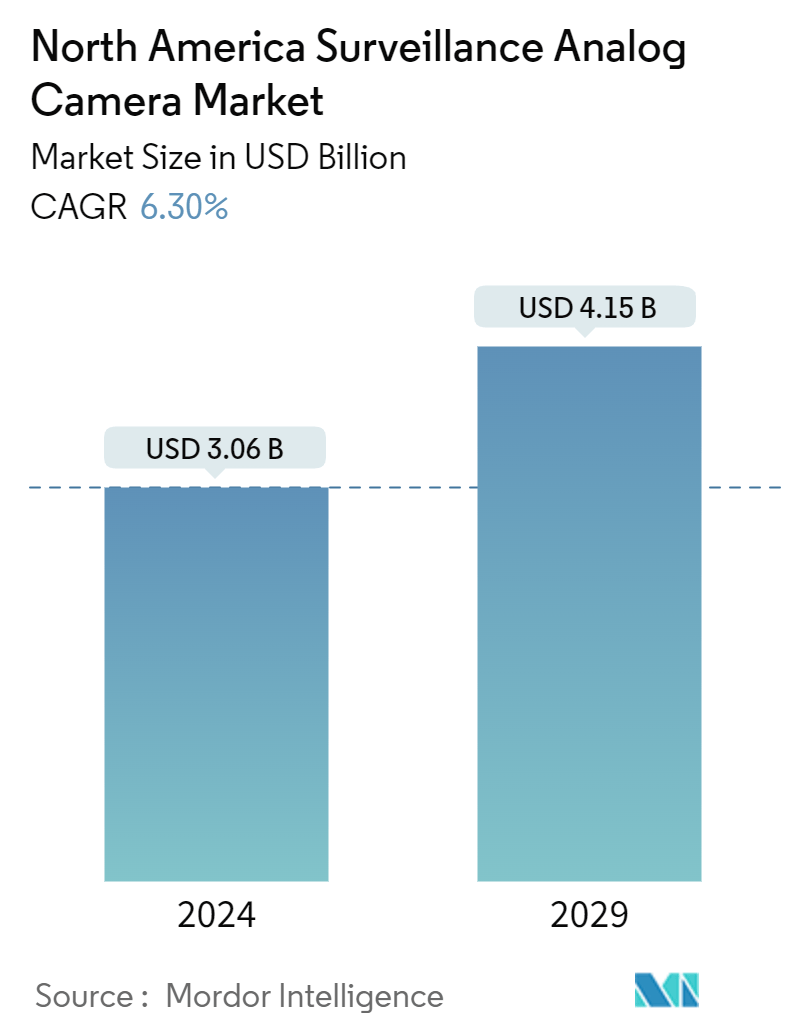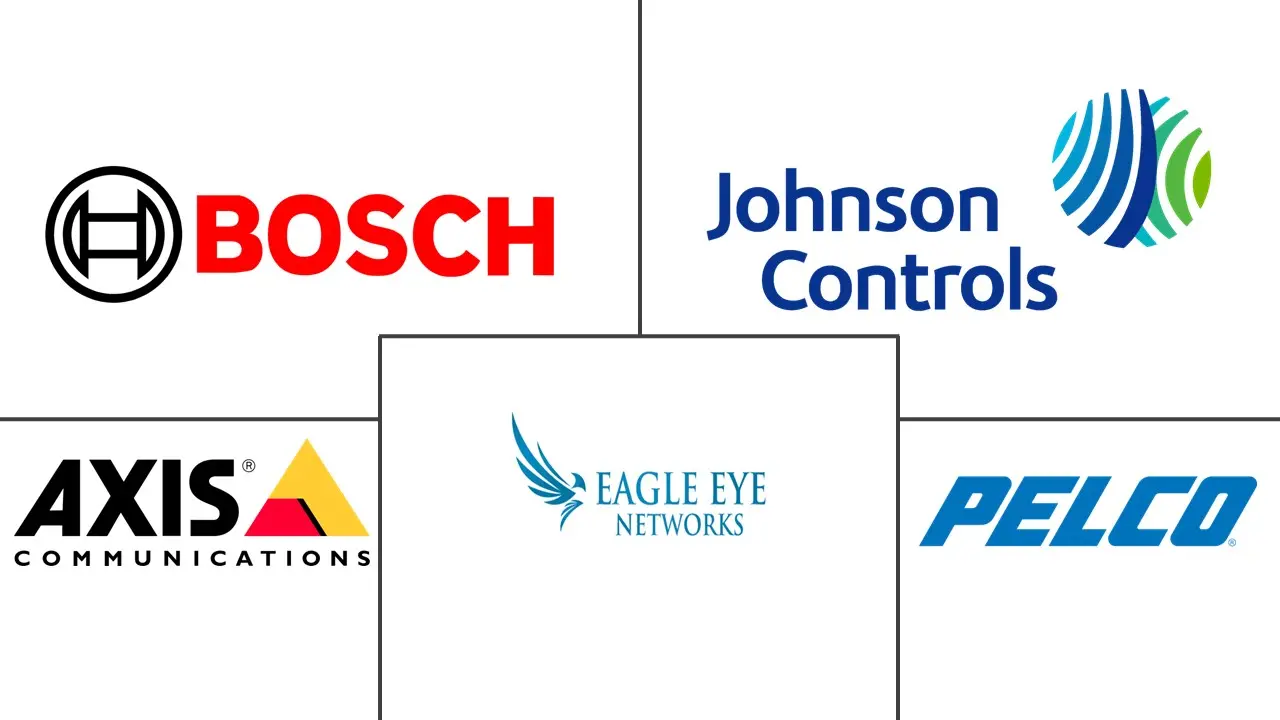
| Study Period | 2019 - 2029 |
| Base Year For Estimation | 2023 |
| Forecast Data Period | 2024 - 2029 |
| Market Size (2024) | USD 3.06 Billion |
| Market Size (2029) | USD 4.15 Billion |
| CAGR (2024 - 2029) | 6.30 % |
| Market Concentration | Low |
Major Players
*Disclaimer: Major Players sorted in no particular order |
North America Surveillance Analog Camera Market Analysis
The North America Surveillance Analog Camera Market size is estimated at USD 3.06 billion in 2024, and is expected to reach USD 4.15 billion by 2029, growing at a CAGR of 6.30% during the forecast period (2024-2029).
- The market share of analog surveillance cameras is dwindling, thanks to the swift progress in digital and IP camera technologies. Consumers and businesses are favoring IP cameras for their superior image quality, scalability, and advanced functionalities, including remote monitoring and seamless integration with other smart devices.
- Despite the declining demand for surveillance analog cameras in North America, there have been notable technological strides. For instance, high-definition analog variants like HD-TVI and HD-CVI deliver superior image quality, all while being compatible with existing coaxial cables, presenting a cost-effective upgrade path for current analog setups.
- Many small- to medium-sized enterprises and residential users find analog cameras to be a cost-effective solution. Their lower initial investment and simpler installation, in contrast to IP cameras, make them appealing to budget-conscious consumers. Notably, products like Lorex's 4K active deterrence analog security bullet cameras and 1080p HD outdoor CVI analog PTZ cameras are gaining traction.
- The surveillance industry, driven by stringent regulations on data privacy and security, favors analog cameras for their lower vulnerability to cyber threats compared to IP counterparts. Moreover, there is a rising preference for hybrid surveillance systems integrating both analog and IP cameras.
- Furthermore, the North American market has seen favorable growth conditions, supported by increased government investments in public safety. As per recent news, Canada is grappling with a surge in crime rates, fueling a growing need for surveillance cameras. The country's Violent Crime Severity Index, which is now at levels not seen since 2007, serves as a stark warning. Disturbingly, the homicide rate has hit a 30-year peak, and incidents of sexual assault are the highest since 1995. Additionally, Statistics Canada's data highlight a troubling trend: firearms-related violent crimes have been on a consistent rise, culminating in 2024, marking the highest levels since data collection began in 2009.
- The market faces a notable hurdle with the rising favor for IP cameras. Analog cameras, on the other hand, struggle to seamlessly integrate with contemporary digital surveillance systems and software. This issue is further exacerbated as businesses and consumers increasingly embrace smart tech and IoT devices.
- Although the broader trend leans toward digital and IP surveillance systems, the analog camera market in North America is poised to maintain a niche. This resilience can be attributed to factors such as cost-effectiveness and the demand for straightforward security solutions.
North America Surveillance Analog Camera Industry Segmentation
A surveillance analog camera is a security device that captures video footage in an analog format, typically transmitting signals over coaxial cables to a recording device or monitor. While they offer cost-effective solutions for basic security needs, analog cameras generally provide lower resolution compared to digital or IP cameras and have limited integration capabilities with advanced surveillance technologies.
The study tracks the revenue accrued through the sale of surveillance analog camera products by various players operating in North America. The study also tracks the key market parameters, underlying growth influencers, and major vendors operating in the industry, which supports the market estimations and growth rates over the forecast period. The study further analyzes the overall impact of macroeconomic factors on the market. The report’s scope encompasses market sizing and forecasts for the various market segments.
The North American surveillance analog camera market is segmented by end-user industry (government, banking, healthcare, transportation and logistics, industrial, and others) and by country (the United States and Canada). The market sizes and forecasts are provided in terms of value (USD) for all the above segments.
| Government |
| Banking |
| Healthcare |
| Transportation and Logistics |
| Industrial |
| Others |
| United States |
| Canada |
North America Surveillance Analog Camera Market Size Summary
The North American surveillance analog camera market is experiencing a gradual shift as digital and IP camera technologies gain prominence due to their superior image quality and advanced features. Despite this trend, analog cameras continue to hold a niche market position, primarily due to their cost-effectiveness and simplicity. Small- to medium-sized enterprises and residential users often prefer analog cameras for their lower initial investment and easier installation compared to IP cameras. Technological advancements have led to the development of high-definition analog variants, such as HD-TVI and HD-CVI, which offer enhanced image quality while remaining compatible with existing coaxial cable systems. This compatibility provides a cost-effective upgrade path for users looking to enhance their security systems without incurring significant expenses.
The market landscape is characterized by a fragmented competitive environment, with both domestic and international players vying for market share. Companies like Hikvision and Bosch Building Technologies are actively innovating and expanding their product offerings to meet the evolving demands of the market. The rising crime rates in regions like Canada have spurred increased government investments in public safety, further driving the demand for surveillance cameras. While the broader industry trend leans towards digital solutions, the analog camera market in North America is poised to maintain its relevance due to its affordability and the ongoing need for straightforward security solutions. The integration of analog and IP systems in hybrid surveillance setups is also gaining traction, catering to a diverse range of consumer preferences and security needs.
North America Surveillance Analog Camera Market Size - Table of Contents
1. MARKET DYNAMICS
-
1.1 Market Drivers
- 1.1.1 Cost Effectiveness and Affordability
- 1.1.2 Utilization of Existing Infrastructure
-
1.2 Market Restraints
- 1.2.1 Technological Limitation
2. MARKET SEGMENTATION
-
2.1 By End-user Industry
- 2.1.1 Government
- 2.1.2 Banking
- 2.1.3 Healthcare
- 2.1.4 Transportation and Logistics
- 2.1.5 Industrial
- 2.1.6 Others
-
2.2 By Country
- 2.2.1 United States
- 2.2.2 Canada
North America Surveillance Analog Camera Market Research FAQs
How big is the North America Surveillance Analog Camera Market?
The North America Surveillance Analog Camera Market size is expected to reach USD 3.25 billion in 2025 and grow at a CAGR of 6.30% to reach USD 4.41 billion by 2030.
What is the current North America Surveillance Analog Camera Market size?
In 2025, the North America Surveillance Analog Camera Market size is expected to reach USD 3.25 billion.


